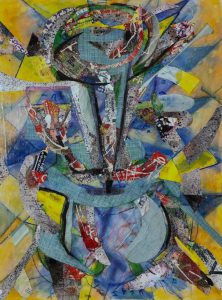
I Think I Love You by GJ Gillespie
The Making of Crazy Fred
Kelly Dorgan
Pieces of Uncle Fred’s story spill out of me. It’s rare, but when it happens, they come like fragments of old family recipes, slipping from a tattered book, symbols nearly indecipherable. I try assembling them, but they crumble under the weight of my cravings. So, I borrow Mom’s memories, pouring them into me, and I churn them, some becoming creamy, others messy. I wish I didn’t have to keep borrowing from Mom. She won’t always be here to help me remake her oldest brother.
Mainly, when I think of Uncle Fred, I see the wooden swing he hung for me with thick, coarse rope from a huge tree. Also, I hear his laugh, rich and savory. But those tasty memories dissolve quickly. Sadly, I’ve bitten into bitter pieces, tougher to swallow. Those are about how he got made into “Crazy Fred.”
Mom grew up on an orchard in Idaho. Over eighty now, she doesn’t talk fondly about the place.
Dusty.
Dark.
These were the main ingredients of her childhood home, at least the way she tells it. I like to believe that she had a good home, that her disgust came, in part, from what happened to her on the school bus.
“Orchard rat,” school kids doused her as soon as she’d climbed aboard. Guess the slur changed her appetite for her orchard home.
There were other ingredients in the complicated mix, though. From what I’ve gathered, her family’s secret ingredient was, well, secrecy.
“No one ever talked about anything,” Mom says.
Usually, her voice is effervescent, a crisp beer on a hot day. But when talking about her childhood, it drips dark, acidy, sweetener noticeably absent. This is especially true when she shares with me any tidbit about how her brother got made—or, more accurately, how he got remade.
In seventh grade, as the story goes, Fred rode his bike down a steep grade. He hit a pothole, sending him flying, his head smashing into hardness. He lay there for hours before anyone found him, and he languished in the hospital for weeks.
This accident was the starter for the making of “Crazy Fred.”
